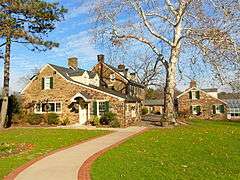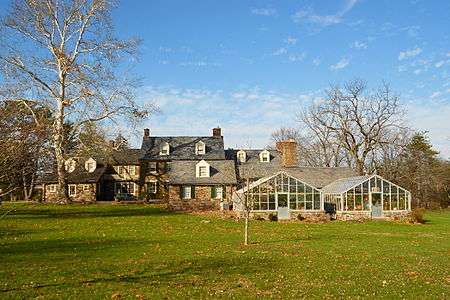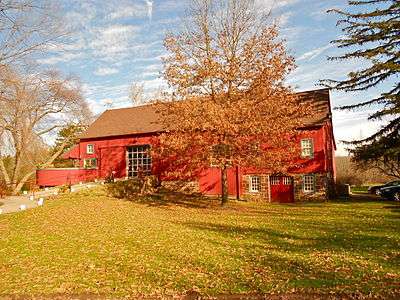Green Hills Farm
|
Green Hills Farm | |
 | |
  | |
| Nearest city | Dublin, Pennsylvania |
|---|---|
| Coordinates | 40°21′36″N 75°13′11″W / 40.36000°N 75.21972°WCoordinates: 40°21′36″N 75°13′11″W / 40.36000°N 75.21972°W |
| Built | 1933 |
| NRHP Reference # | 74001755 |
| Significant dates | |
| Added to NRHP | February 27, 1974[1] |
| Designated NHL | January 16, 1980[2] |
Green Hills Farm, also known as the Pearl S. Buck House, is the sixty-acre homestead in Bucks County, Pennsylvania, where Nobel-prize-winning American author Pearl Buck lived for 40 years, raising her family, writing, pursuing humanitarian interests, and gardening. She purchased the house in 1933 and lived there until the late 1960s, when she moved to Danby, Vermont.[3] She completed many works while on the farm, including This Proud Heart (1938), The Patriot (1939), Today and Forever (1941), and The Child Who Never Grew (1950).
Overview
The Pearl S. Buck House at Green Hills Farm, an example of 19th century (built 1825[4]) Pennsylvanian architecture, is constructed of coursed fieldstone. It is four bays wide and two deep with the main entrance located in the second bay. Two gable dormers are located on the front and rear slope of the roof. Chimneys are located on each gable end. When Buck purchased the farmstead, she made extensive alterations and additions to the 19th century farmhouse, including a two-story fieldstone wing added to the east gable and two libraries. Today, visitors can tour twelve rooms of the home and visit the pre-Revolutionary War cottage on the property and the barn built in 1827.
The interior melds the two worlds that so greatly shaped the life of this renowned author. In the large library, two Pennsylvania jugs serve as lamp bases upon a beautifully hand carved Chinese hardwood desk, at which Buck wrote her breakthrough novel The Good Earth. Buck filled her home with interesting works of original art by Chen Chi and Freeman Elliot , iron works of art produced by exiled artisans in China, Peking Fetti carpets that survived revolutions in China, and some of her own sculptures.
The Pearl S. Buck House became a National Historic Landmark in 1980 and opened as a museum the same year. The estate, now on the National Register of Historic Places, is owned and operated by the Pearl S. Buck Foundation. 17,000 people visit each year.It sits on over 67 acres of manicured lawns, gardens and ponds. The house also contains two green houses and is open to the public for tours 7 days a week.[4]
-

House
-

Barn
Notes
- ↑ National Park Service (2007-01-23). "National Register Information System". National Register of Historic Places. National Park Service.
- ↑ "Buck, Pearl S., House". National Historic Landmark summary listing. National Park Service. Retrieved 2008-07-02.
- ↑ Green Hill Farm (Pearl S. Buck House) National Park Service
- 1 2 Preservation/Restoration of the Pearl S. Buck House National Historic Landmark National Trust for Historic Preservation
References
- "Green Hill Farm (Pearl S. Buck House)" (Online). Delaware and Lehigh National Heritage Corridor: A National Register of Historic Places Travel Itinerary. National Park Service. Retrieved 2007-01-27.
- "Preservation/Restoration of the Pearl S. Buck House National Historic Landmark" (Online). Lowe's Charitable and Educational Foundation Preservation Fund. National Trust for Historic Preservation. Retrieved 2007-01-27.

